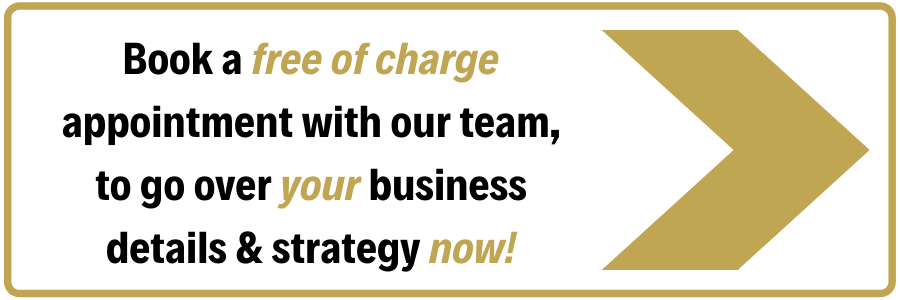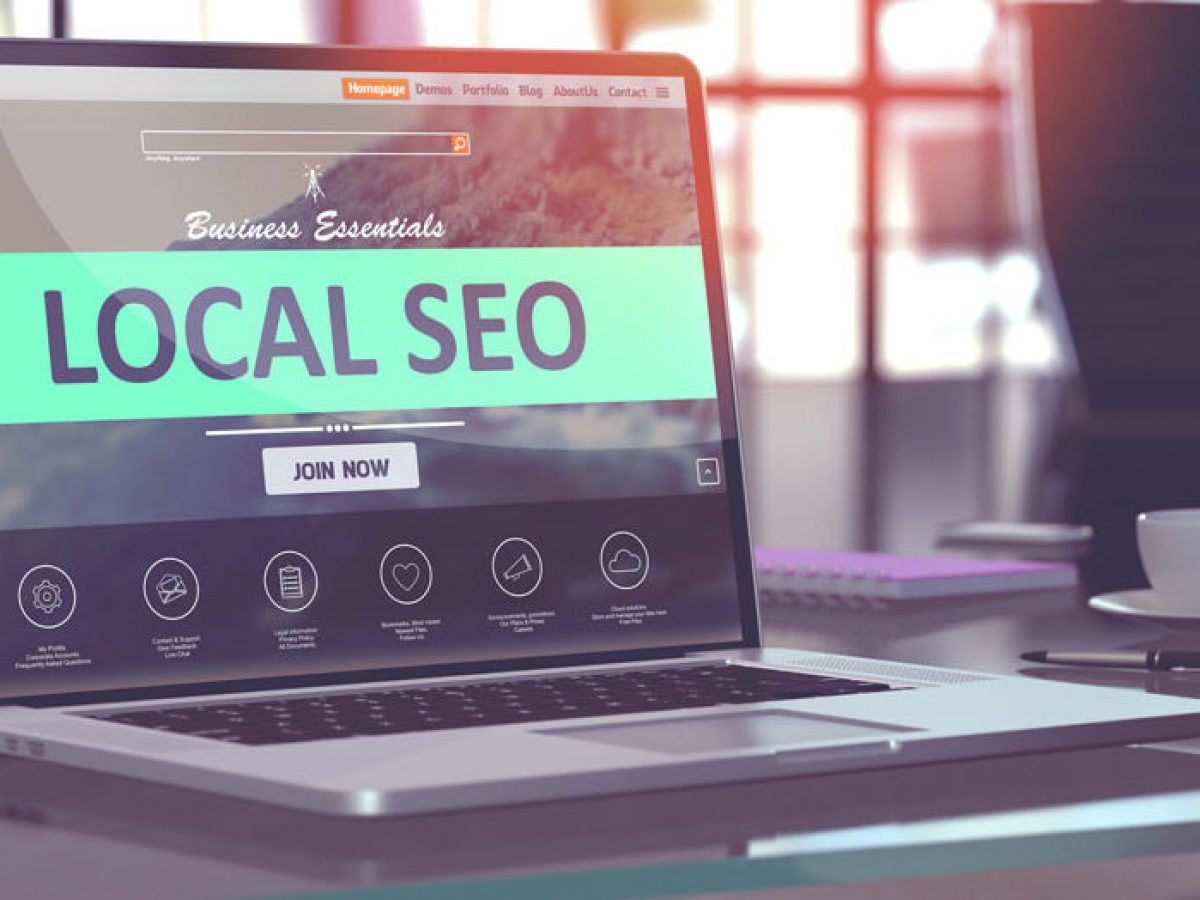
This post may contain affiliate links. Click here to find out more about this.
Table of Contents
Google’s Pigeon algorithm update marked the beginning of a crackdown on local SEO. They slashed the local pack to three listings, weakened the relevance of directory links, shifted and shrank targeted geographic regions, and that was just the beginning. Here are the 14 Tactics that Revives Local SEO.

Over the past few years, Google has made it easier for large, recognizable brands to dominate local search and harder for the small, local places to stay relevant.
And they make no effort to hide it. Just take this directly from Google’s local ranking documentation:
“For example, famous museums, landmark hotels, or well-known store brands that are familiar to many people are also likely to be prominent in local search results.”
You may have even noticed famous logos popping up on Google Maps over the past year.

That’s a tough break for local restaurants. So far, Google has only offered this feature to select major brands like McDonald’s, Walgreens, and Kohl’s.
So you can no longer just target keywords like [business type] + [city], create a small blog, then spam directories and social media to get on the first page of Google.
However, the good news is that Google’s search algorithm doesn’t actually care about big business any more than you. What it cares about is satisfying users and creating happy customers.
And many times, small and independent local businesses still offer the best value to their customers.
You just have to show them that you deserve it. Check out the 14 Tactics that Revives Local SEO
Why does shrinking local SEO matter?
Today, 96% of Americans shop online. If you’re a small local business, that might sound scary.

See How My Agency Can Drive Massive Amounts of Traffic to Your Website
SEO – unlock massive amounts of SEO traffic. See real results.
Content Marketing – our team creates epic content that will get shared, get links, and attract traffic.
Paid Media – effective paid strategies with clear ROI.
But there is hope. That same report found that the average American still spends 65% of their shopping budget in-store.
That means despite all the noise, traditional retail is still alive and well.
Traditional marketing, however, is not.
In 2017, the most common way consumers found out about a small business for the first time was through online research.
At nearly 37% of the population, the Internet even beat out word of mouth (at 35%), which has been the lifeblood of local business pretty much since words have existed. Tactics that Revives Local SEO
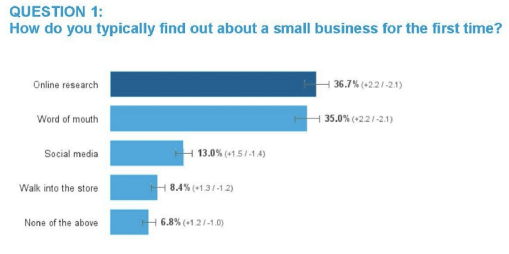
That’s not even including the 13% who said that social media was the place they were most likely to discover a small business.
Add them in, and you’re looking at nearly 50% of all consumers who find new local businesses primarily online!
While people are still shopping and spending in-store, they’re searching and making critical decisions about who to visit while online.
If customers can’t find you there, you effectively don’t exist.
Even if they do hear about you from a friend first, you can bet they’ll type your name into Google before deciding to give your business a visit.
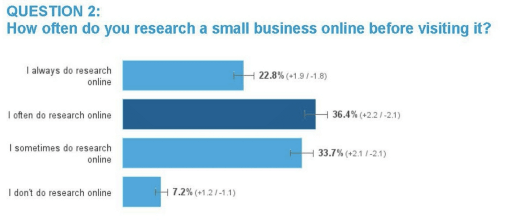
Out of everyone in the survey, only 7.2% of people said they don’t do any online research before visiting a small business.
That means that you need to have a strong online presence.
In fact, nearly half of all Google searches today have local intent. And once someone does a local search, there is a 72% chance they will visit a store within 5 miles of their location.
Ranking as a local business today is harder than ever.
But if you’re willing to put in the legwork, Google will reward you with those competitive top spots and all the leads, customers, and sales that they command.
The two main ways to rank locally
One of the unique things about local SEO is that there are two different ways to rank. And the factors differ a bit for each. If you want to win at local SEO, you need to pay attention to both.
The first way to rank is the local pack ranking. The local pack includes the top three results that Google Maps shows for a local search.

This is effective “position zero” on the search engine results page (SERP) because they appear before the normal organic results. Here are the 14 Tactics that Revives Local SEO.
It creates an immediate connection with potential customers who want something convenient and tangible by seeing your close location.
The second way is through localized organic ranking. This is just traditional SEO but focusing on targeting localized keywords and backlinks to reach local customers.
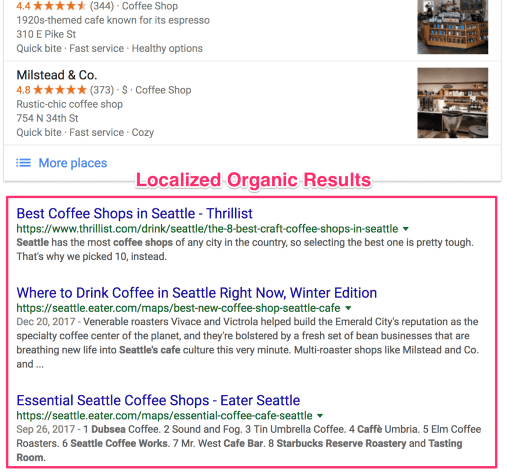
These are still critical as the highest-ranking results will still be the first websites that customers see.
Google explains how they determine these rankings in very broad terms: relevance, distance, and prominence.
We can’t change your store’s location, but we can show you how to beat the competition with relevance and prominence.
Each year, Moz compiles a report that takes those broad factors and breaks them down into more finite categories.
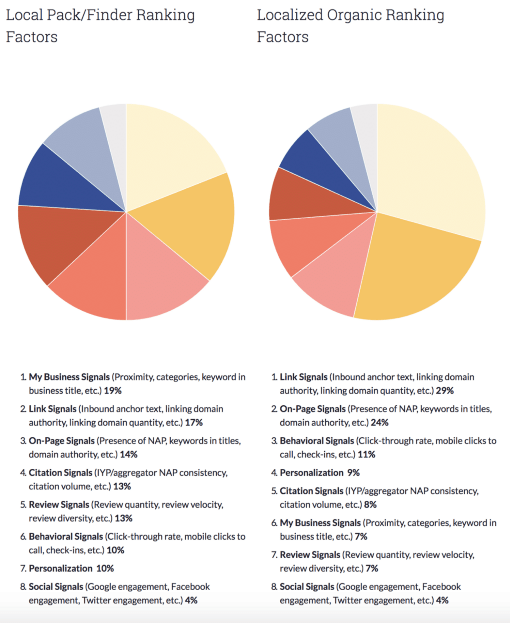
Google considers the same eight factors for both types of ranking. The only difference is how much weight they give to them.
So, if you find yourself in the local pack but not the first page of localized organic results, you just need to shift your focus slightly.
Anything you do to improve one will improve the other. Tactics that Revives Local SEO
14 Tactics that Revives Local SEO
In this guide, we’re going to show you 14 tactics to fight back against big brands and other competition to revive your local SEO ranking.
Tactic 1: Conduct a local SEO audit
Before you get too deep into tactics, you should conduct a short audit to ensure you have all the basics covered.
Tactic 2: Make sure your NAP is consistent across the entire web
Matt McGowan is the Head of Advertising Strategy at both Google and YouTube on local SEO. And he says that this is one of the most important things you can do for a local search.
You need to make sure that your NAP (name, address, and phone number) is correct not just on Google My Business but also across all your social media profiles and various online directories.
If Google finds conflicting information for your business, it may not attribute any information to you. Or worse, you could be penalized.
Tactic 3: Implement Schema
Once you get your information consistent across the web, you need to make sure that your website is easy for search engines to read and process.

You won’t need to know any HTML or coding to set this up. We have a handy step-by-step guide on structured data to help.
Once you implement this, all major search engines will easily read and index your contact information for search.
Tactic 4: Focus on mobile
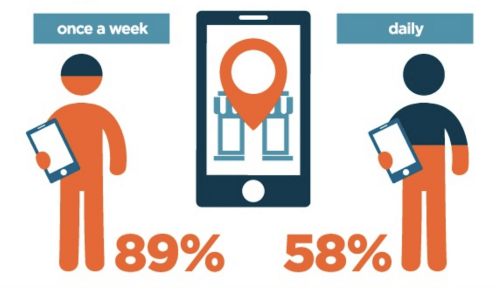
The data also shows that these searches have actionable intent. As many as 78% of those queries result in an offline purchase.
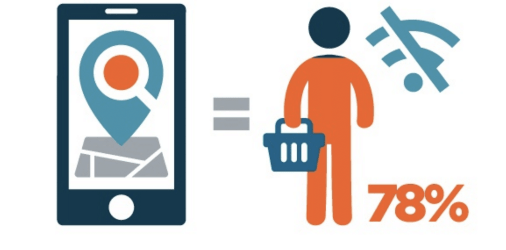
Like with any website, Google tracks click-through, conversions, and other user behavior to gauge whether you are the best option to meet customer needs.
With this segment making up an increasingly large portion of local searches, you’d be crazy not to prioritize the mobile experience.
There’s one super easy update you can make right now that businesses ignore.
Just take a look at your local ranking factors under “Behavioral Signals,” and you’ll see it: Mobile Clicks to Call.
That means that Google specifically watches how often customers visit your site and click on your phone number to contact you.
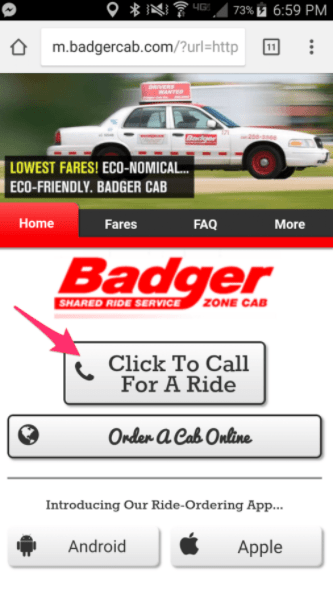
In marketing, there is a golden rule.
Make it as easy as possible for your customers to do what you want. The more friction you remove, the more likely they will be to take your desired action.
In this case, you’re making it easy for them to get in touch with you so that you can sell them on your business. As a bonus, you’ll start to see your Google ranking climb.
And it only takes 60 seconds. It’s as simple as adding a web link to your site.
Normally, a link on your site would look like this in HTML.
www.mysite.com/about
To make that link open a phone’s dial pad, you just need to add the “tel:” prefix inside the tag. Following that, type the number as the link destination.
tel:5555555555
Or it could look like this.
tel:5555555555
If you’re using WordPress or another HTML-editing tool, you should be able just to hit the “Add Link” icon and enter tel:5555555555.

In all of the examples above, replace “5555555555” with your phone number.
You can put this anywhere a normal link can go — within the text, a button, an image, or anywhere. Tactics that
Revives Local SEO
Tactic 5: Get more reviews
Review signals are a major ranking factor, accounting for 13% of the local pack rank and 7% of your localized organic rank.
Besides, 85% of consumers said that they trust online reviews as much as personal recommendations. And 30% said that it’s the key decision factor when judging a local business.
It shouldn’t surprise you that Google seems to favor Google Reviews the most. So that’s what we’re going to focus on.
So we’re going to show you how you can make it painless for customers to give you a Google review.
First, make sure that you’ve set up Google My Business and claimed your listing.
Once you’ve taken care of that, go to the Google Places API.
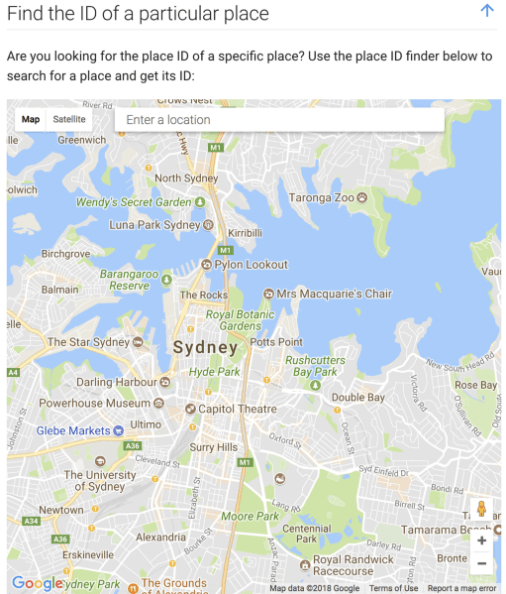
Search for your business.
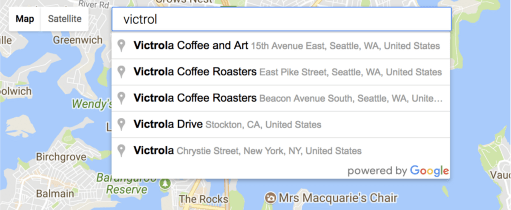
Then copy down your place ID.
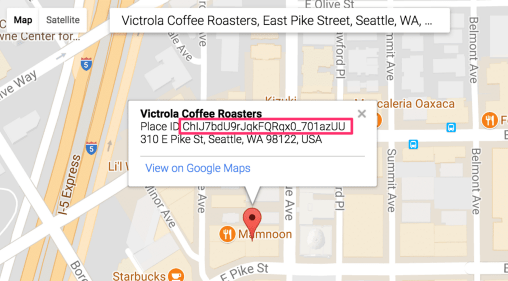
And add it to the review URL as you see here:
https://search.google.com/local/writereview?placeid= ChIJ7bdU9rJqkFQRqx0_701azUU
Now anyone you send this link to will be prompted to leave your business a review.
You can take a step further to make it even easier for the customers to give you what you want.
Here’s how:
Drop that URL into a private browser (like Chrome’s Incognito mode).
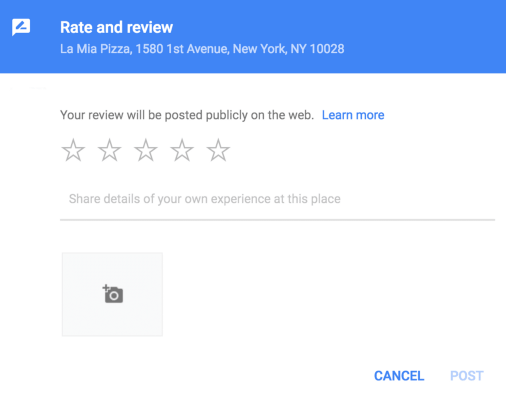
But look at the address bar. Can you see how the URL expanded?
Well, if you add a “5”(a comma followed by the number 5) to the end, it will prepopulate the stars for the customer and increase the chance that they leave a 5-star review.
So entering this:
,5
I Will get you this:
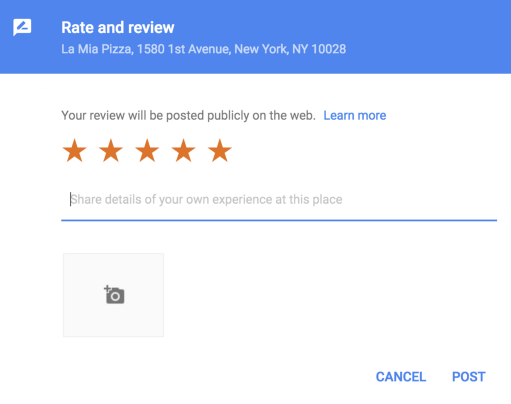
Lastly, it’s a good idea to clean that link up with the Google URL shortener before sending it to customers. That will leave you with something like this:
You can send this link in your thank-you emails, Facebook chats, and even text messages.
https://goo.gl/k65uPX
But here’s a word of caution: Be careful to follow the rules for each site you’re on.
For example, Google does not allow you to incentivize reviews, and Yelp points out that it may be illegal.
Getting caught violating these terms can get you penalized heavily.
Tactic 6: Respond to those reviews
This is another one that I see people neglecting a lot. And it’s especially true of businesses with high ratings, which is a big mistake.
If you get a bad review, don’t let it stress you out. It happens to everyone.
What matters is how you handle it. You should always respond with grace and sincerity.
The majority of customers expect a business to respond to bad reviews, and 25% of people say that they should hear back within 24 hours.
If you receive a bad review, responding is a chance to take ownership, apologize, and explain your side of the story.
Just be sure to respond to the criticism well.
If you’re lucky, that customer might even post a revised review after you worked with them on a solution.
But even if you can’t persuade the disgruntled customer, new customers will have a complete picture when checking your reviews and are more likely to give you their business.
Most business owners know they should be responding to negative reviews. But what about positive ones?
What about positive reviews?
If a customer took time out of their busy schedule to endorse your business and say something nice about you online, the least you can do is thank them.
It doesn’t have to be much. Just tell them that you appreciate the kind words and hope to see them again soon. It takes 5 seconds.
Whether their feedback is good or bad shows that you value your customers and their feedback when you respond to feedback and reviews publically.
Tactic 7: Build more local backlinks
Link building is one of the cornerstones of any SEO strategy. That’s because Google uses them as an indicator that your site is providing valuable and relevant content.
It would help if you always were working on getting as many backlinks from authoritative sites as possible.
Local SEO is no exception. But there is a twist. The term “authoritative” takes on a different meaning here.
For local businesses, Google knows that the most authoritative sources are those in your local community.
So while a backlink from BuzzFeed will still be valuable, you might get even more value from a simple press placement in your local online newspaper or community newsletter.
That’s good news because local links should be much easier to get. But how do you go about getting them?
Well, there are lots of ways to do it. The rest of these strategies will explain specific ways that you can build local backlinks.
Tactic 8: Target top-ranked directories
In the former days of local SEO, it was common practice to spam your NAP to every directory online.
Each link gave you a big boost. It was all quantity over quality.
But those days are long gone.
Google now does a much better job of recognizing page authority and fighting against such spam tactics.
So how do you know which directories are worth paying attention to?
Focus on the ones with the highest organic ranking. These are usually the sites that show up right below the local pack on Google.
Let’s say that you run a dry cleaning shop in the Seattle area. Here are the results you would want to focus on.

You’ll want to spend most of your efforts on Yelp, Foursquare, and TripAdvisor.
Now, if your market is especially competitive, it helps to click through to page two and fill out those directories. It certainly won’t hurt you.
If you are in a very competitive market, you might want to try this next strategy.
Tactic 9: Find missing link opportunities and inconsistent data
Moz Local is a great tool for finding local link opportunities, especially when targeting localized directories.
Since things are constantly changing online, there is always room to improve your local directory listings and earn new backlinks.
You should routinely analyze with the free lookup tool.
Just head to the following site: moz.com/products/local
Then click the “Check My Listing” button.
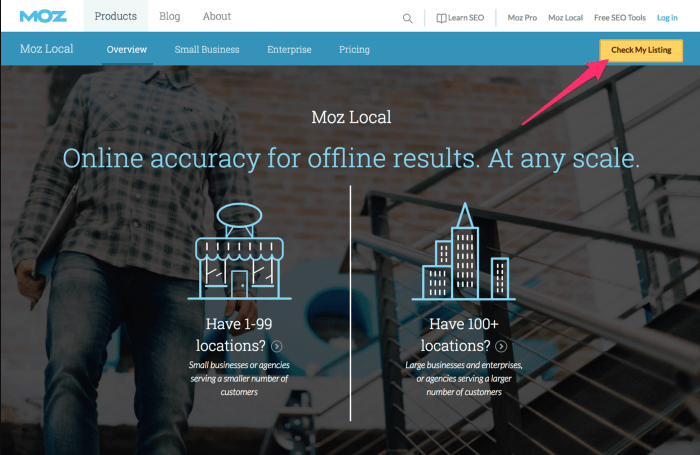
Search for your business.
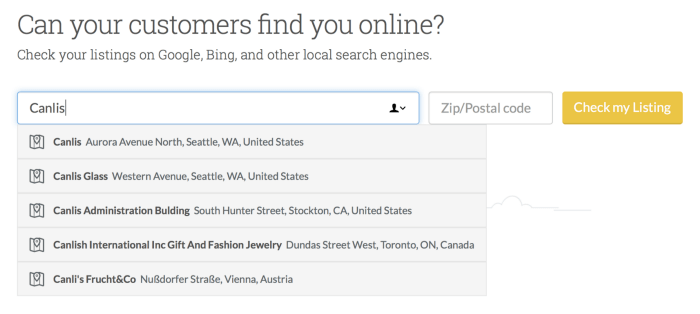
Then, you’ll get a complete report of your status on different directories and local sources.
Of course, you want as close to 100% as possible. But since things are always changing, generally, anything above 80% is doing pretty well.
This is an example of an excellent result.
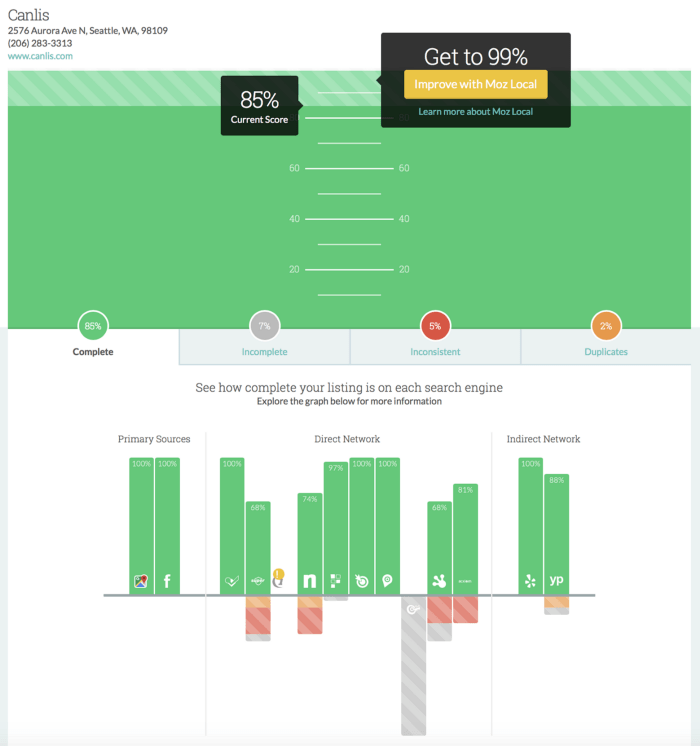
While Moz Local has some useful paid features to help manage your profiles, you can already do a lot for free with this data.
If you visit the “Incomplete” tab, you’ll find recommendations for ways to make your online profiles more robust.
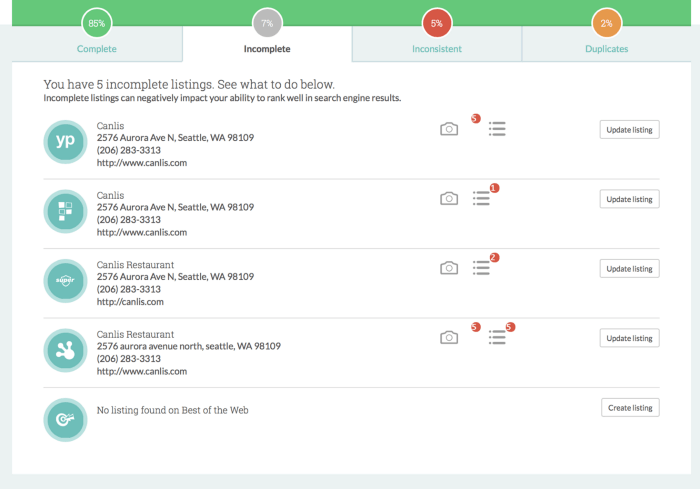
We can see here that some of the smaller directories could use more photos and category information to maximize their exposure.
To do this, just click the “Update listing” button, and the listing will launch in a new tab.

It also looks like there is one additional link opportunity here by creating a new local directory listing (Best of the Web).
Just like you would with updates, click on “Create a listing.”

Moz Local will automatically launch the directory that needs updating. Once there, locate the “claim link” that will let you register as an owner and make changes to the listing.
This looks different on every directory, but it usually resembles one of these:
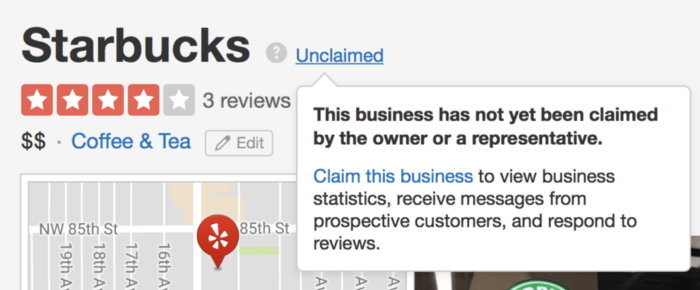


You should also pay special attention to the “Inconsistent” tab and note any errors in red. This highlights where your NAP varies on different profiles.
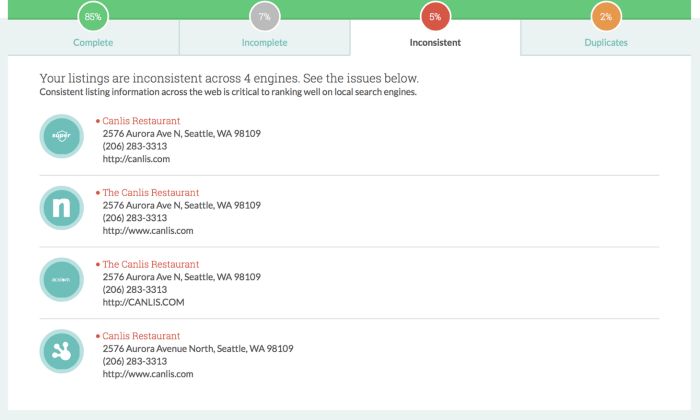
In this case, it just appears to be that the word “The” appears on some sites. We wouldn’t worry much because Google shouldn’t have trouble understanding that these are the same place.
But what should alarm you are differences in the address or outdated contact information. If you have those mistakes, Google will penalize you in local search.
Updating those profiles with consistent NAP and website information would be a quick SEO win. Just head over to those sites and update your information.
Tactic 10: Contact your local Chamber of Commerce
Almost every city or region in the United States has a Chamber of Commerce that dedicates itself to helping the local business community thrive.
Find yours online and contact them.

Ask if they have a business directory to add you to or another place they can link you.
Some common examples other than directory listings are:
- A profile write-up about you or your business
- Coverage of a community event that you are sponsoring
- Congratulatory announcements for national awards
Tactic 11: Partner with other local businesses
While you’re looking at the chamber of commerce directory, check for other businesses in your community that serve the same customers as you without competing directly.
For example, if you own a nail salon that provides services like manicures and pedicures, try partnering with a hair salon in your neighborhood. You probably share a lot of the same target customers.
You can cross-promote and link to each other from your respective websites. This will not only send you referral traffic but will also improve your local backlink profile.
One common way to do this is by adding a partner’s page to your site and exchanging links there.
Or, if they have a blog, you can offer to write a guest post about something their customers would find interesting and link back to your business inside the article.
Tactic 12: Target the competition’s links
This strategy is a bit more aggressive than the others. But it’s totally fair, and I wouldn’t be doing my job if I kept it from you.
You can use Ahrefs or a similar tool to see who is linking to your local competition. Then, ask them to link to you instead.
First, head over to Ahrefs and put your competitor’s website in the search bar.
Then click on the number under “Referring domains.”
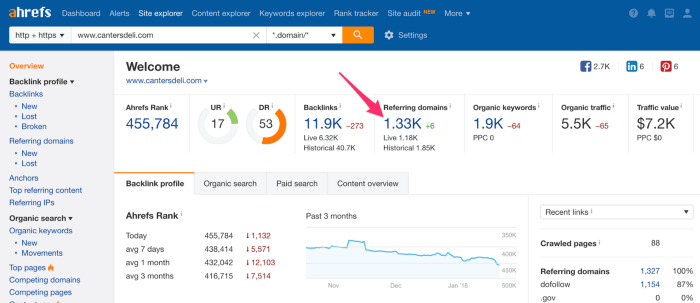
This will show you a list of all the sites that link to their website.

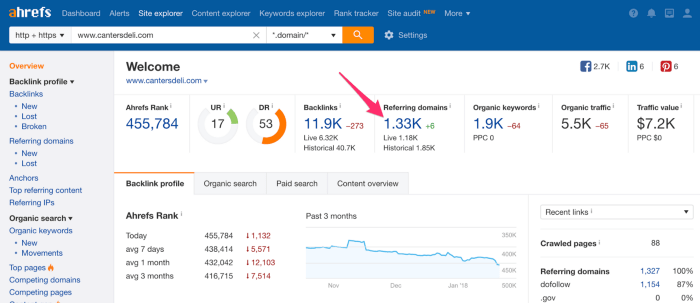

Get to know these sites, network with them, and build a rapport.
Then get them on the phone or send them a quick email saying something like this:
“Hey,
I noticed that you’re linking to XYandZ.com. We have a similar business [insert link here] in the same region, but we also offer A, B, and C services that they don’t.
So you should also check us out. It may be useful for your visitors. And if you like us, feel free to link to us.
Cheers,
[Name]”
I find that it really helps if you get to know the site and its team before making the pitch, especially if it’s a well-established site.
If you truly offer more services or better value to their readers, there’s no reason why they wouldn’t want to link to you. Check the 14 Tactics that Revives Local SEO
Tactic 13: Build links with uncredited brand mentions
This is one classic strategy that still works today.
Whenever someone mentions your brand or business online, there is an opportunity to earn a backlink.
You just have to monitor the web for these mentions and then politely reach out to ask for the link when they forget.
Ahrefs has a handy guide that shows you three strategies that you can use to find those mentions and how to get in touch with the appropriate webmasters to claim those links you already earned.
Tactic 14: Create localized content
This last strategy from 14 Tactics that Revives Local SEO is a specific form of content marketing.
Localized content is great because it creates a deep and emotional connection with your audience.
You can literally hit them right at home.
Good content marketing is just about finding what your niche is interested in and creating great content around that.
When it comes to localized content, that niche has to be in your community.
By showing that you understand and care about the community, you set yourself apart from generic and out-of-town competitors.
A great way to get ideas for localized content is to enter your neighborhood’s name into BuzzSumo and see what’s getting the most shares.
But don’t let that limit you. You should feel free to use your local expertise to come up with your own ideas as well.
That’s especially important if you live in a smaller town or city.
Being creative will always help you stand out.
Once you’ve created the content, make sure that you share it on social media and encourage your friends to share it as well.
Send copies to your local newspaper so that they can share them on their website and give you a localized link.
Conclusion
So maybe local SEO isn’t completely dying. Maybe it’s just evolving.
But the fact remains: Local SEO is getting harder. But it’s also more important than ever.
If you simply keep doing what you’ve always done, your business will soon fall behind.
The good news is that you now have an alternative to this fate.
You now have the tools you need to compete with big brands and local competition. You are ready to lift your company’s rank to the top of both the local pack and the organic search results.
First, make sure that you complete a local SEO audit and verify that your NAP is consistent across the web.
Then do some on-site optimization by implementing Schema markup and prioritizing mobile performance. And don’t forget to add click-to-call to make it easy for your customers to get in touch with you.

See How My Agency Can Drive Massive Amounts of Traffic to Your Website
SEO – unlock massive amounts of SEO traffic. See real results.
Content Marketing – our team creates epic content that will get shared, get links, and attract traffic.
Paid Media – effective paid strategies with clear ROI.
Once you get all of that in place, you’ll want to build a strong review profile by encouraging customers to leave reviews. Then be diligent about responding to them.
After all that, you should see some serious ranking lift. But don’t stop there. Go all the way with some serious localized link building.
Don’t hold back. Use all the different link strategies I gave you.
Prioritize top-rated directories before heading over to Moz Local and verifying all your local profiles.
Contact your local Chamber of Commerce and partner with complimentary local businesses by exchanging links (and referrals).
Use Ahrefs to target competitor links and find an uncredited brand that mentions that the site owners could update to give you a localized backlink.
If your market is very competitive, you can stand out with a localized content marketing strategy and collect even more backlinks in the process.
Just remember that any type of SEO is a long-term strategy. It takes consistent work and dedication to quality.
But if you follow these strategies diligently, your reward will be a place among those coveted top-ranking positions and the droves of customers that come with them. 14 Tactics that Revives Local SEO

